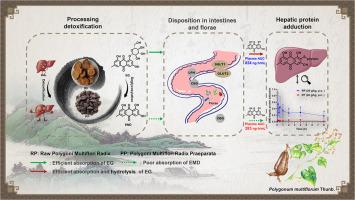Phytomedicine ( IF 6.7 ) Pub Date : 2023-03-11 , DOI: 10.1016/j.phymed.2023.154750 Xu Wang 1 , Guode Zhao 1 , Chengguo Ju 2 , Lingwen Dong 1 , Yuyang Liu 1 , Zifang Ding 1 , Weiwei Li 3 , Ying Peng 1 , Jiang Zheng 4

|
Background
The occurrence of severe liver injury by the herbal medicine Polygoni Multiflori Radix (PMR) has drawn significant attention. The fact that processing attenuates PMR-induced hepatotoxicity has been well accepted, but the mechanisms are still ambiguous.
Purpose
This study aimed to illuminate the mechanism of processing-based attenuation of PMR hepatotoxicity.
Methods
The contents of emodin-8-O-β-d-glucoside (EG) and emodin (EMD) in raw and processed PMR were quantified. The difference in toxicokinetic behaviors of EG and EMD was determined in vivo, and the disposition properties of EG were investigated in vitro and in vivo.
Results
Decreased EG content was found in processed (black bean) PMR. Processed PMR showed reduced adverse effects relative to raw PMR. In addition, less hepatic protein adduction derived from EMD was produced in mice after exposure to processed PMR than that in animals receiving raw PMR. Glucose transporters SGLT1 and GLUT2 participated in the absorption of EG, and effective hydrolysis of EG to EMD took place in the intestinal epithelial cells during the process of absorption. Cytosolic broad-specificity β-glucosidase and lactase phlorizin hydrolase, as well as intestinal flora, participated in the hydrolysis of EG. The circulated EMD resulting from the deglycosylation of EG executed the hepatotoxic action.
Conclusion
EG is a pre-toxin and can be metabolically activated to EMD participating in the hepatotoxic event. The reduction of EG content due to processing is a key mechanistic factor that initiates the detoxification of PMR.
中文翻译:

减少大黄素-8-O-ß-D-葡萄糖苷含量参与何首乌的基于加工的解毒
背景
草药何首乌 (PMR) 引起严重肝损伤的事件引起了人们的极大关注。加工减弱 PMR 诱导的肝毒性这一事实已被广泛接受,但其机制仍不明确。
目的
本研究旨在阐明基于加工的 PMR 肝毒性减弱的机制。
方法
对原始和加工的 PMR 中大黄素-8- O-β - d-葡萄糖苷 (EG) 和大黄素 (EMD) 的含量进行了量化。测定了EG和EMD在体内的毒代动力学行为差异,并研究了EG在体外和体内的处置特性。
结果
在加工的(黑豆)PMR 中发现 EG 含量降低。与原始 PMR 相比,经过处理的 PMR 显示出减少的副作用。此外,与接受原始 PMR 的动物相比,在暴露于加工过的 PMR 后,小鼠产生的来自 EMD 的肝蛋白内收较少。葡萄糖转运蛋白SGLT1和GLUT2参与EG的吸收,在吸收过程中,EG在肠上皮细胞中有效水解为EMD。胞质广泛特异性 β-葡萄糖苷酶和乳糖酶根皮苷水解酶以及肠道菌群参与 EG 的水解。由 EG 去糖基化产生的循环 EMD 执行肝毒性作用。
结论
EG 是一种前毒素,可被代谢激活为参与肝毒性事件的 EMD。由于加工而导致的 EG 含量减少是启动 PMR 解毒的关键机制因素。































 京公网安备 11010802027423号
京公网安备 11010802027423号